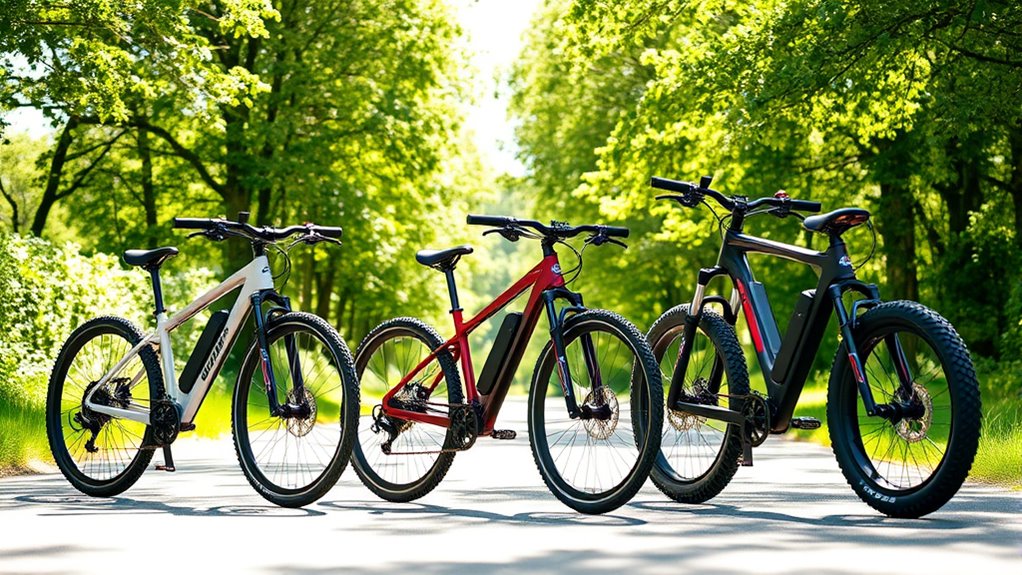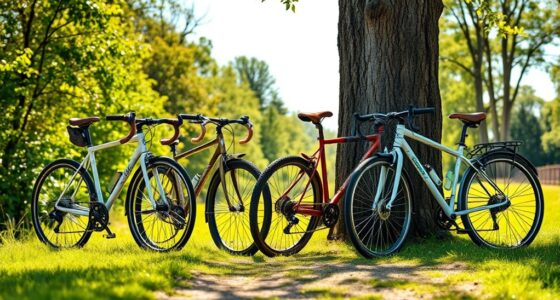E-bike classes help you understand how different bikes operate and their legal use. Class 1 bikes have pedal assist only and stop aiding at 20 mph, making them great for casual riding. Class 2 bikes include a throttle for motor power without pedaling and can go faster. Class 3 bikes offer pedal assist up to 28 mph for longer rides, but often have more restrictions. Keep exploring if you want to learn more about each class and their features.
Key Takeaways
- Class 1 e-bikes are pedal-assist only, with motor support up to 20 mph, suitable for beginners and casual riders.
- Class 2 e-bikes feature throttle mode, allowing motor activation without pedaling, with speeds up to 20 mph.
- Class 3 e-bikes provide pedal assist up to 28 mph, designed for faster, longer rides on designated bike lanes.
- Battery technology across all classes ensures quick starts, long-lasting power, and efficient performance.
- Legal restrictions vary by class, influencing where and how each type of e-bike can be legally ridden.

Are you curious about the different types of e-bike classes and what they mean for your riding experience? Understanding the distinctions between Class 1, 2, and 3 e-bikes can help you choose the right one for your needs, especially when it comes to battery technology and riding safety. Each class offers a different riding experience, and knowing how they operate guarantees you stay within legal boundaries while enjoying your ride.
Class 1 e-bikes are pedal-assist bikes that provide power only when you pedal. The motor activates as soon as you start pedaling and stops assisting when you reach 20 mph. Because they rely solely on pedal effort, their motors typically feature advanced battery technology that offers long-lasting power with quick recharge times. This makes them ideal for casual commuting or recreational riding, especially since they tend to be lighter and easier to control. From a safety perspective, Class 1 bikes are generally safer for beginners because their speed is limited, reducing the risk of losing control or crashing. Plus, since the motor only assists when pedaling, your actions directly influence the bike’s behavior, keeping you more engaged and aware of your surroundings.
Class 1 e-bikes offer pedal assist up to 20 mph with advanced, long-lasting batteries for safer, beginner-friendly riding.
Class 2 e-bikes step up the assistance by providing a throttle mode that allows you to engage the motor without pedaling. This means you can accelerate just by pressing a button or twisting the throttle. The battery technology used in Class 2 bikes is often similar to that of Class 1, with powerful, rechargeable batteries designed for quick starts and sustained power. However, because they can reach higher speeds without pedaling, they may present more safety concerns, especially if you’re unfamiliar with handling higher speeds. It’s vital to practice riding cautiously and wear proper safety gear, like a helmet, because sudden acceleration can catch you off guard if you’re not attentive. Some regions restrict or regulate throttle-only bikes, so understanding your local laws is key to riding safely and legally.
Class 3 e-bikes combine features from the first two classes, offering pedal-assist up to 28 mph. They typically incorporate advanced battery technology to support higher speeds and longer rides. Since these bikes can go faster, they demand more from your riding safety skills. You need to be extra cautious when handling higher speeds, especially on busy roads or uneven terrain. Because Class 3 bikes often include more sophisticated motors and batteries, they tend to be slightly heavier, which can impact maneuverability. That’s why mastering control and understanding your bike’s capabilities are vital. Also, many areas restrict Class 3 bikes to bike lanes or specific paths, so knowing local regulations helps you ride responsibly.
Frequently Asked Questions
Are E-Bike Classes Consistent Across All States and Countries?
You’ll find that e-bike classes aren’t consistent across all states and countries because regional regulations and international standards vary. Some places might follow strict definitions for speed and motor power, while others have more relaxed rules. It’s essential to check local laws before riding or purchasing an e-bike, as class distinctions can differ markedly, impacting where and how you can ride legally.
Can I Switch Between E-Bike Classes During a Ride?
Sure, you can switch between e-bike classes during a ride—if you’re lucky enough to find a bike that’s compatible with multiple classes. But don’t count on it; bike class compatibility isn’t always seamless, especially with recent e-bike regulation changes. Many regions don’t allow switching mid-ride, aiming to keep everyone safe and legal. So, unless you’re a stunt rider, it’s best to pick your class before hitting the road!
Do E-Bike Class Restrictions Vary for Different Age Groups?
Yes, age restrictions and license requirements do vary for different age groups. You might find that younger riders, often under 16, need to meet specific age limits and may require a license or helmet. Older riders usually face fewer restrictions, but it is crucial to verify local regulations to make certain you’re compliant. Always review your area’s rules before riding to avoid penalties and ride safely within legal limits.
Are There Specific Safety Gear Requirements for Each E-Bike Class?
You should always wear a helmet, as helmet requirements are typically mandated by local laws for all e-bike riders. Protective gear standards also suggest gloves, knee, and elbow pads for added safety. While specific safety gear requirements might vary by region or e-bike class, following these guidelines helps protect you during rides. Check your local regulations to make sure you’re complying with any additional safety gear standards for your e-bike class.
How Do E-Bike Classes Impact Insurance Coverage?
Sure, your e-bike class can turn your ride into a game of insurance roulette. Class 1 bikes might get you basic liability coverage, while Class 3 could mean higher premiums or limited claims. If you crash, expect insurance claims to vary wildly based on your bike’s class, making it essential to understand how your class impacts liability coverage. Don’t assume your insurance will cover everything—know your class, know your coverage.
Conclusion
Now that you know the ins and outs of e-bike classes, you’re better equipped to pick the perfect ride for your adventures. Whether you’re cruising leisurely or tearing up the trails, understanding these classes helps you stay on the right side of the rules. Remember, choosing the right e-bike is like finding the right tool for the job — it makes all the difference. So, get out there and enjoy the ride, because the world’s your oyster!









